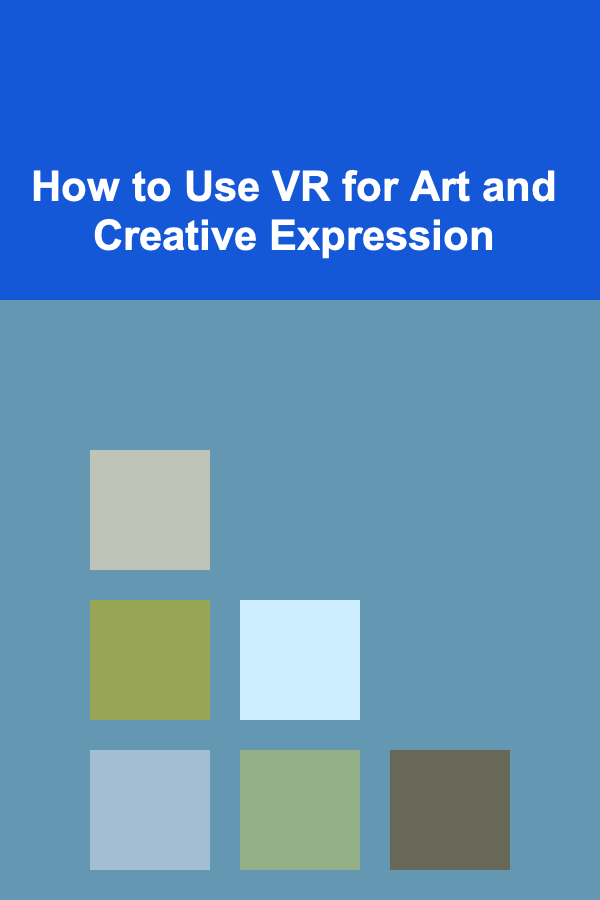
How to Use VR for Art and Creative Expression
ebook include PDF & Audio bundle (Micro Guide)
$12.99$7.99
Limited Time Offer! Order within the next:

Virtual Reality (VR) has evolved beyond its origins in gaming and entertainment to become an exciting tool for artists and creatives. Artists, designers, and creators from a variety of disciplines are now exploring how VR can enhance their work, offering an immersive medium that traditional tools simply can't match. By using VR, creators are not limited by the constraints of physical space or traditional materials; instead, they can shape entire worlds in 3D, interact with their creations in real-time, and push the boundaries of their imagination.
In this article, we'll explore how VR is changing the landscape of art and creative expression, offering insights into how you can use VR in your own creative practice, the benefits and challenges of this technology, and examples of artists and projects that have successfully embraced VR for art.
What is VR Art?
Virtual reality art is the process of creating art within a VR environment, where the artist can manipulate digital elements in a fully immersive 3D space. Unlike traditional forms of art, where the artist is typically working on a two-dimensional surface or within a fixed physical space, VR art offers the ability to work in an entire 360-degree environment. This allows for greater interaction, fluidity, and interactivity.
There are several ways VR is used in the artistic process:
- 3D Painting and Sculpting: Tools like Google Tilt Brush and Oculus Medium allow artists to paint, draw, and sculpt in a 3D environment. Artists can use virtual brushes, textures, and tools to create intricate, three-dimensional designs.
- Virtual Galleries and Exhibitions: VR can be used to design virtual art galleries and exhibitions, allowing people to experience art in new, virtual spaces without needing to be physically present.
- Interactive Art: VR allows artists to create immersive, interactive works where the audience can move through the artwork and even influence its shape and structure.
- Sound and Music: VR is also being used to create sound-based art, where soundscapes can be designed in a 3D virtual space, allowing the user to "move" through different layers of sound.
Key Tools for VR Art Creation
To start creating art in VR, there are a variety of tools that you can use, including:
- Tilt Brush: One of the most popular VR painting tools, Tilt Brush by Google allows artists to paint in 3D space. Artists can work with a variety of brushes, textures, and materials, creating stunning visual art within an immersive virtual environment.
- Oculus Medium: A powerful sculpting tool for creating 3D models in VR. Artists can manipulate virtual clay in real-time, perfect for creating sculptures, characters, and complex forms.
- VRoid Studio: An intuitive VR-based character creation tool that lets you design anime-style avatars for virtual worlds, games, and even VR performances.
- Artful: A digital painting app designed for the Oculus Quest, Artful allows users to create paintings within a 3D space using their hands and a virtual canvas.
- Blender VR: Blender, a widely used 3D design program, can also be used for VR creation. While Blender itself is not VR-native, it can be adapted for VR use with certain plugins or additional hardware.
Examples of VR Art Projects
- The Night Cafe VR: Based on Vincent van Gogh's iconic painting "The Night Cafe," this VR experience allows users to step inside the painting, interact with its elements, and even change its structure. It blurs the lines between classical art and digital interactivity.
- Tilt Brush Residency : The Tilt Brush Residency was an initiative by Google to support artists who were interested in working with VR. Artists like Olivier C., who used VR to create stunning abstract landscapes, have showcased their work through these residencies.
- VR Music Videos : Some musicians are now using VR to create immersive music videos. For instance, Bjork's VR project "Vulnicura" allows viewers to experience the artist's music in a completely new, immersive way.
Benefits of Using VR for Art and Creativity
2.1 Immersive Creativity
One of the most significant advantages of VR in art is its immersive nature. VR enables artists to step inside their creations and interact with them in real-time. For instance, instead of just drawing on a 2D canvas, artists can explore their ideas in 3D space and manipulate them as they go. This immersive environment allows for a more tactile experience with the art and offers endless creative possibilities.
2.2 Boundless Creativity
In a physical space, artists are limited by the materials available to them and the constraints of the environment. In VR, however, these limitations are removed. There is no need for traditional tools like paint, brushes, or canvases, and there are no physical restrictions. Artists can use any medium---be it light, texture, or even sound---and manipulate objects in ways that would be impossible in the physical world. They can create structures that float in midair, or design entire virtual landscapes that can be explored by the viewer.
2.3 Real-Time Collaboration
VR also opens up new possibilities for collaboration. Multiple artists can work together on a single VR project in real time, making changes, adding elements, and sharing ideas instantaneously. This fosters a unique form of collaboration that transcends the limitations of physical space. Whether artists are in different parts of the world or sitting side by side, they can work together seamlessly.
2.4 Accessibility
Another great benefit of VR for art is the accessibility it offers. Traditional art tools and spaces can be expensive and difficult to access for many artists, especially those living in remote areas or under financial constraints. VR provides an accessible platform where artists can experiment with new techniques without needing expensive physical materials. Additionally, VR experiences can reach global audiences, making art more accessible to people who might not have the means to visit galleries or attend live performances.
Challenges of VR Art
While VR presents exciting opportunities, it is not without its challenges. These challenges stem from the technology itself, the learning curve for users, and the limited hardware available to some users.
3.1 The Learning Curve
Using VR for art can be quite different from traditional art techniques. There is a learning curve involved, particularly if you are not familiar with 3D modeling or digital art tools. Artists must learn how to navigate virtual environments, how to use VR-specific software, and how to manipulate objects in 3D space. For many, this may require time and patience, as well as technical know-how that extends beyond traditional artistic skills.
3.2 Expensive Hardware
High-quality VR tools and hardware can be expensive. In order to create VR art, you need not only a powerful computer but also a VR headset and controllers. This can be a barrier for artists who are just starting and don't have the budget to invest in the necessary equipment. The cost of VR equipment continues to decrease, but it is still a significant factor for many potential users.
3.3 Limited Spatial Awareness
In the virtual space, it can be difficult to develop the same level of spatial awareness and muscle memory that one might have when working with physical materials. Artists working in VR have to navigate and manipulate their virtual creations in three-dimensional space, which can feel disorienting at first. Even with the best hardware, VR art is still a relatively new experience, and the lack of tactile feedback can be an obstacle for some creators.
3.4 Technological Limitations
While VR has come a long way, it still has limitations in terms of graphical quality, interactivity, and scalability. Some artists may find that VR tools are still not as advanced or flexible as their traditional counterparts. Furthermore, VR experiences require high levels of computational power, which means that creators may face performance issues if they don't have the best equipment.
The Future of VR Art
The future of VR art is incredibly exciting. As VR technology continues to evolve, we are likely to see even more advanced tools and applications for creative expression. With faster processors, better graphics, and more affordable hardware, VR will become even more accessible to artists worldwide.
4.1 Augmented Reality (AR) and Mixed Reality (MR)
While VR allows for full immersion into a virtual environment, augmented reality (AR) and mixed reality (MR) bring the virtual world into the real one. These technologies will allow artists to blend the physical and digital worlds, creating new ways of interacting with both. Artists will be able to overlay their creations on real-world surfaces, opening new possibilities for public art, installations, and performances.
4.2 AI-Driven Art
Artificial intelligence (AI) is already being integrated into VR art tools, offering artists new ways of creating. AI algorithms can be used to generate or alter aspects of the artwork in real-time, helping the artist push their creative boundaries further. As AI technology improves, artists may be able to interact with their creations in ways that feel more like collaboration than creation.
4.3 VR as a New Art Form
As VR technology becomes more mainstream, it may give rise to a new art form altogether. We may start seeing entirely new genres of art that are designed specifically for virtual spaces. This could range from fully immersive art exhibitions to virtual performance art that allows the audience to interact with the performers and the environment. Artists will continue to push the boundaries of what's possible within VR, creating a new frontier for creative expression.
Conclusion
Virtual reality is changing the way we create and experience art. It offers a unique, immersive environment where artists can create interactive, 3D worlds that defy the limits of traditional art forms. While there are still challenges to overcome, such as the steep learning curve and expensive hardware, VR is already proving to be a powerful tool for creative expression.
As VR technology continues to improve, it will open up even more possibilities for artists to explore new realms of creativity, collaboration, and interactivity. Whether you're an artist looking to experiment with new techniques or a creator eager to push the boundaries of your work, VR offers an exciting and ever-evolving medium for artistic expression.
The future of VR in art is boundless, and we're only scratching the surface of what's possible. So, if you're an artist looking for a new way to express yourself, now is the perfect time to dive into the world of VR.

How to Create a Fun and Functional Shared Workspace
Read More
How to Handle Multiple Job Offers: A Decision-Making Guide
Read More
How to License Your Deep Learning Models for Profit
Read More
How to Organize a Family Talent Show at Home
Read More
How to Transform Your Home into a Winter Wonderland with Simple Decor Ideas
Read More
10 Tips for Business Coaches to Help Startups Secure Funding
Read MoreOther Products

How to Create a Fun and Functional Shared Workspace
Read More
How to Handle Multiple Job Offers: A Decision-Making Guide
Read More
How to License Your Deep Learning Models for Profit
Read More
How to Organize a Family Talent Show at Home
Read More
How to Transform Your Home into a Winter Wonderland with Simple Decor Ideas
Read More